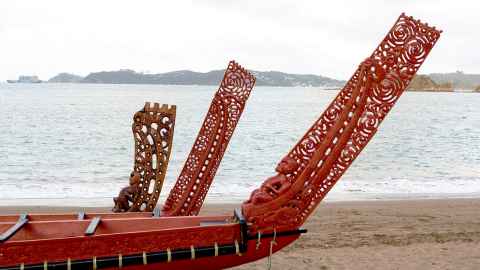New Zealand must learn lessons of 1918 pandemic and protect Māori from COVID-19
30 March 2020
Opinion: Chronic health problems and a lack of access to hospitals threaten another calamity for Indigenous people unless they are protected, writes medical student Emma Espiner.

Two years ago I was at a public health seminar on the lessons of the 1918 influenza pandemic. Historians, epidemiologists and public health physicians marked the 100th anniversary of the global disaster by dissecting outcomes in clipped, professional tones. Sadly, Māori were badly affected. Unfortunately, Māori died at a rate seven times that of non-Māori. Regrettably, the health system response was inadequate for Māori.
In 2020 we still have many of the conditions which led to the appalling death rate of almost 5% of all Māori from influenza in 1918-19.
We are still dealing with systemic racism, the underprovision of health services in areas where Māori live, material poverty, and the consequences of the state-led destruction of our health-protective factors – language, land, culture, resources, whānau.
Last week Te Whānau a Tuwhakairiora, a hapū from the east coast of the North Island, declared they were instituting community safety checkpoints at their tribal boundaries. The first I heard of it was a journalist posting a copy of the polite letter from the tribal leaders to the national campervan association, advising that its members would not be able to access the area due to the risk of infecting the locals with COVID-19. Some commentators decried the “vigilantes” and called on the government to stamp it out.
Peeni Henare, a government minister, told journalists that he backed tribal authorities taking these steps to protect their people. This is a big deal because, despite boasting the “largest ever” Māori caucus, this government has been light on advocacy for Māori when it clashes with the philosophy of universalism which underpins this majority-Pakeha political party. I don’t doubt that the party would have preferred Henare to have a more neutral position on the issue but he spoke from his principles and, as Māori, we all heard him.
Notwithstanding the courage of Henare’s position, the bare facts show that it is a reasonable public health intervention to mobilise around the physical entry points to this community. Tairawhiti district health board is unusual in this country in that it is almost 50% Māori, against a national prevalence of approximately 16%. It also has one of the lowest life expectancy rates for Māori at just 69 compared with 81 years for the general population. The population is more sick than the rest of New Zealand, and the list of chronic conditions reads like a neat summary of Covid-19 risk factors; diabetes, chronic respiratory disease, cardiovascular disease, asthma, hypertension. Stories have been flooding in from all over the country of tourists who think they’re self-isolating because they’re in an isolated part of the country. My blood runs cold thinking about the potential for harm if a major outbreak were to occur here, three hours away from a hospital, with only six ICU beds for the entire region.
But I also want you to know how valuable this population is. When my grandmother left Tikitiki in the northern reaches of the east coast to marry my grandfather, she brought our language back to our whānau. Raised with te reo Māori, she supported my grandfather and our extended iwi at Ngāti Tukorehe, an hour’s drive from Wellington, to fill our paepae with speakers of our indigenous tongue. She was able to do this because of the richness of her whakapapa – her heritage – from being raised in a predominantly Māori setting. Almost one third of Māori in Tairawhiti can hold a conversation in te reo Māori, a language which was almost destroyed by colonial malice. This isn’t about preserving a group of helpless invalids, but ensuring our cultural treasures and way of life are protected.
It suits some people to brand Māori as radicals or activists or vigilantes. It suits them to put civilised society into one box and put the rest of us into a troublesome “other” box, and suggest that we’re out to take civil society’s toys. They think we would do to them what they did to us.
It’s important not to overstate the actions taken by Te Whānau a Tuwhakairiora – it’s effectively the same as any community group acting responsibly during non-pandemic times. For example at a school gala, or a big cultural festival, you’d place staff or volunteers at key positions to ensure public safety. For Māori, it would be a breach of our tradition of manaakitanga – taking care of others – not to do so.
The reality is, now as in 1918, we are not yet equipped nor motivated to deliver sufficient protection and care for Māori. Extraordinary measures have been enacted by the government for everyone, but in order to protect our indigenous people we need to do more, and history tells us that we need to do it ourselves if necessary.
Advertisement
The National Māori Pandemic Group has set up this website with COVID-19 advice and resources for Māori.
Emma Espiner (Ngāti Tukorehe, Ngāti Porou) is a writer and final year medical student in the Faculty of Medical and Health Sciences. She comments on social issues, health and politics for Newsroom and is the host of Getting Better, a RNZ podcast about Māori health equity.
This article reflects the opinion of the author and not necessarily the views of the University of Auckland.
Used with permission from The Guardian, New Zealand must learn lessons of 1918 pandemic and protect Māori from COVID-19, 25 March 2020.
Media contact
Nicola Shepheard | Media adviser
DDI: 09 923 1515
Mob: 027 537 1319
Email: n.shepheard@auckland.ac.nz